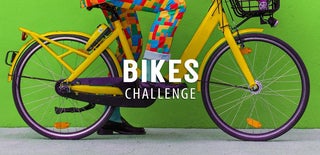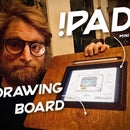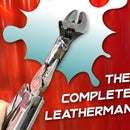Introduction: Quarter Camper, a Bike Caravan
For a very long time, I've wanted to make a camping solution for my bike. I've got some great examples in my Pinterest board but they were all a bit large and clunky. I had gotten an old trolly that was in need of a makeover and quickly that became the base for this project.
I made it a challenge to see if I could make this bike camper a miniature caravan, with everything included.
This project had been on the backburner for a while, but with Covid19 it all made sense and this spring was all about camping and self-isolation… The quarter Camper, a one-person bike caravan was born!
Supplies
This is "a take what you have and make the best out of it" type of project.
I've pretty much used every tool in my toolbox:-)
Step 1: Inspiration
I have little experience with caravan life but have always been fascinated by the idea of tiny living. Also, tiny houses come up regularly in my Netflix feed:-)
The caravan above I got to see inside in Sweden, it was undergoing renovation but gave a clear example of living small. At the beginning of the summer my favorite maker, Laura Kampf, started her venture into converting a horse trailer into a camper. Fantastic inspiration and her project involved some of my challenges too.
To make my project as fun and inspiring as possible I set out to build my bike caravan based on what a real caravan would hold for comfort and utilities. Here's a shortlist of what it should contain:
Cooking facilities
Washing oportuneties
Sleeping compartment
& last but not least a toilet!
Everything else would be a bonus…
Step 2: Where It All Began…
This trolly had seen better days. All rusted up and the tires were more than flat! But it had all the parts intact and the size was perfect. Even the handle was at the right height and angle for connecting to the bike.
I took the wheels apart and gave them a paint job, grease, and new tires.
Now let's do the fun part, build the camper…
Step 3: The Camper…
This part has very few process photos because I was so into the building I totally forgot to document the build. As this is a very custom construction due to the build fitting an already trolly, you hopefully see where I ended up and that will at best inspire you to design your own solution.
I've used foldable tent poles for holding the roof up! Later I added a pole (leftover bamboo) to make the construction more solid.
I will go into more detail as this Instructable progresses, hold tight!
Step 4: Storage Bonanza
The storage planning was a bit challenging, I had collected a bunch of stuff I wanted to include. This heap of gear needed to get its own spot and compartment. I knew I wanted drawers to hold the most essential stuff and one would hold the cooking facilities.
To have easy access I made the drawers also accessible trough a lid covering all three.
Step 5: Cooking Time!
Ok so this set up doesn't invite to a master chef experience, but I don't need that, this burner heats water and cooks a simple meal. In addition, I bring a fireplace where I can grill my veggies and meat:-)
The burner is removable so you can take it out and cook in the open!
Step 6: The Sink
Again this had to be space-saving and a simple design that would attach to the outside of the camper. It's made up of the same material as the cover for the camper. With 4 holes in each corner and a pocket for the wooden pegs. By twisting the corners you get a bowl shape to hold the water.
Step 7: Sleeper "Compartment"
The length of the Quarter Camper fits me exactly, my feet go in under the camper while my upper body is covered by the roll-out tarp.
The sleeping pad is rolled up and placed at the font of the trolly.
Step 8: The Campooper
This part could be an Instructables in it selves. Maybe the most important part of camping is the toilet, for may this is what hinders them from enjoying the great outdoors for more than a day. This solution comes after many trips and experiences that could have been nicer.
With weight and space limits this design does the job, I s(h)it comfortably and it folds up into three pieces. I'm adding a bag holder for when I can't dig a hole.
As you can see it's been around and it stood the test.
Step 9: Wheel Stoppers
To make the camper sable and locked in, I made a pair of wooden angles with a thick rubber band to hold them tight at the base of the wheel. Spray painted to hold off water and dirt.
Step 10: Stand Still!
Traditional caravans have legs you extend to level and fix so your home stays in place. First off I had made these wooden legs that would fold out when parked, but I quickly realized that would be a weight and space issue.
My solution was to make some retractable legs that would go up into the camper construction held in place by screws. I welded two identical (yep, the should have been mirrored:-) locks for the aluminum legs. I drilled holes in the outer and inner parts of the camper to slide away from the legs and have the screw bolts on the outside.
When parking I attached a level on the outside so when lowering the first leg I could adjust it and have a perfect position before putting down the second leg and finally swinging out the thrid back leg.
That third leg is key to making the whole thing 100% stable. It's held in place by a 3D printed lock and when pulled out a spring brings it into position.
Step 11: Acessories…
I had great use of my 3D printer. For so many details I could custom design solutions to make feet, locks, tighteners, bolt holders, etc. I made them all in Orange using the Prusa PETG filament for robustness and weather toughness. Designed in Fusion 360.
As this project progressed I went a little overboard and started to tweak and make so many special parts I hope they all will come to use.
But again 3D printing made it so much more fulfilling to make that custom fit to tie in with everything else.
The design is based on a 6mm rope.
Step 12: Outer Tent
The camper and its roll out roof works well when the weather is nice and smooth, but for a rainy day I wanted some more cover. So like traditional caravans I made an outer tent cover for wind and rain. This was material form an old worn out tent, with parts of it still being good enough for my camper:-) This was a bit of a hack, where I eyeballed the the cutting but by some miracle the old tent had practically the same shape as my roof. I sewed in som enforced seams and could leave the bottom part untouched. Eylets were hammered in so I could easily stitch the two tents together.
This was no jo for a windy day, but I all took just about a an afternoon.
To this day my trips have been I good weather so I have no proof this would keep all or just some rain out.
Step 13: First Trip Out…
It was fantastic! I was lucky with the weather and no need for the outer tent cover. Got to test most of the facilities, including you know what…
I pulled both the bike and the quarter camper all the way to the campsite and that turned out to be a bit of a heavy load

Grand Prize in the
Bikes Challenge














